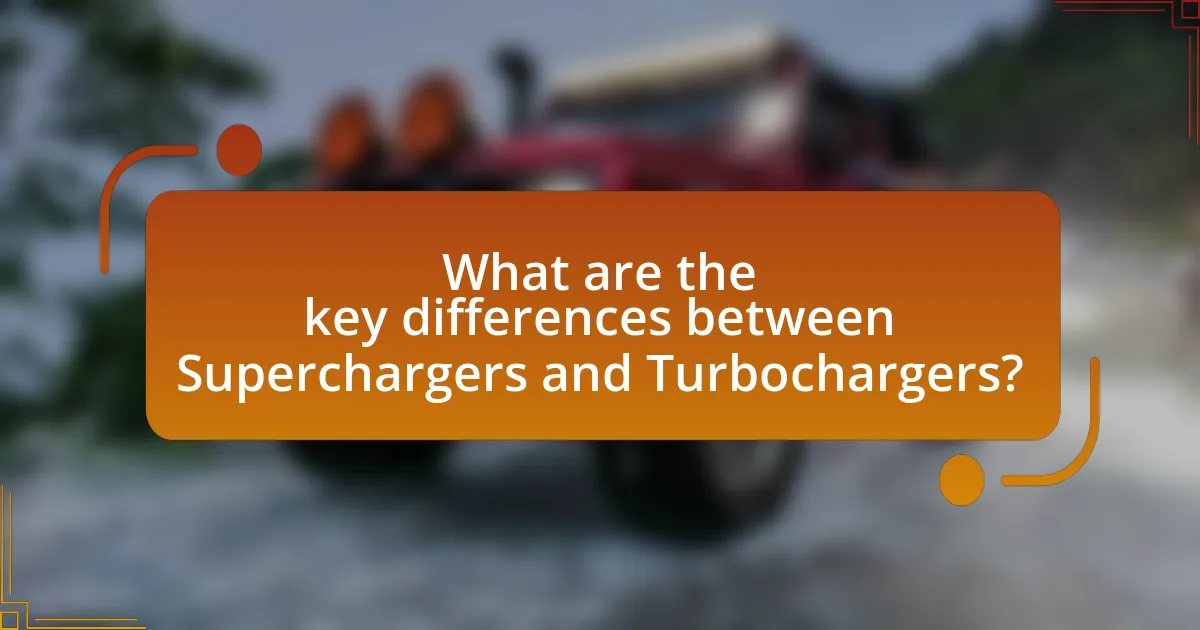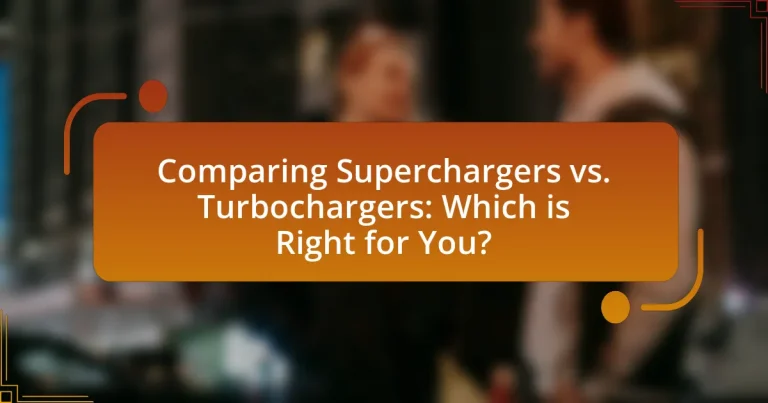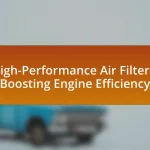Superchargers and turbochargers are both forced induction systems designed to enhance engine power output by compressing intake air, but they operate on different principles. Superchargers are mechanically driven by the engine’s crankshaft, providing immediate power and responsiveness, while turbochargers utilize exhaust gases to spin a turbine, which can introduce a delay known as turbo lag. This article compares the two systems, detailing their mechanisms, components, advantages, and disadvantages, as well as factors to consider when choosing between them based on driving style, performance needs, and budget. Additionally, it addresses common misconceptions and offers tips for making an informed decision regarding performance upgrades.

What are Superchargers and Turbochargers?
Superchargers and turbochargers are forced induction systems that increase an engine’s power output by compressing the intake air. Superchargers are mechanically driven by the engine’s crankshaft, providing immediate boost and power at lower RPMs, while turbochargers utilize exhaust gases to spin a turbine, which can lead to a delay known as turbo lag before power is delivered. Both systems enhance engine efficiency and performance, but they operate on different principles and have distinct characteristics that affect their suitability for various applications.
How do Superchargers work?
Superchargers work by compressing air before it enters the engine, which increases the amount of oxygen available for combustion. This process enhances engine performance by allowing more fuel to be burned, resulting in increased power output. Superchargers are typically driven directly by the engine’s crankshaft through a belt, which means they provide immediate power boost without the lag often associated with turbochargers. The efficiency of superchargers can be observed in their ability to deliver power across a wide range of engine speeds, making them effective for various driving conditions.
What are the main components of a Supercharger?
The main components of a supercharger include the compressor, drive mechanism, intercooler, and housing. The compressor is responsible for increasing the air pressure entering the engine, which enhances performance. The drive mechanism, often a belt connected to the engine, powers the compressor. An intercooler cools the compressed air before it enters the engine, improving efficiency and performance. The housing encloses these components, providing structural integrity and directing airflow. These components work together to boost engine power and efficiency effectively.
How does a Supercharger affect engine performance?
A supercharger enhances engine performance by increasing the amount of air and fuel mixture entering the engine, resulting in greater power output. This forced induction system compresses air before it enters the combustion chamber, allowing for more efficient combustion and increased horsepower. For instance, superchargers can boost engine power by 30% to 50% or more, depending on the engine design and supercharger type. This increase in power is particularly noticeable at lower RPMs, providing immediate throttle response and improved acceleration.
How do Turbochargers work?
Turbochargers work by using exhaust gases to spin a turbine, which in turn compresses incoming air into the engine’s intake. This process increases the amount of air and fuel that can be burned, resulting in more power output from the engine. The turbine is connected to a compressor via a shaft; as exhaust gases flow through the turbine, they cause it to rotate, which drives the compressor to draw in and compress more air. This mechanism allows turbocharged engines to produce more power without significantly increasing engine size or weight, making them efficient for performance enhancement.
What are the main components of a Turbocharger?
The main components of a turbocharger are the turbine, compressor, center housing, and bearing system. The turbine converts exhaust gas energy into mechanical energy, while the compressor draws in and compresses air to increase engine power. The center housing connects these two components and contains the bearing system, which supports the rotating assembly and allows for smooth operation. Each component plays a critical role in enhancing engine efficiency and performance, making turbochargers a popular choice in modern automotive engineering.
How does a Turbocharger influence engine efficiency?
A turbocharger enhances engine efficiency by utilizing exhaust gases to compress incoming air, allowing for more air and fuel to enter the combustion chamber. This process increases the engine’s power output without significantly increasing its size or weight. According to studies, turbocharged engines can achieve up to 20-40% better fuel efficiency compared to naturally aspirated engines, as they extract energy from exhaust that would otherwise be wasted. This efficiency gain is particularly beneficial in smaller engines, where turbocharging can provide the power of a larger engine while maintaining lower fuel consumption and emissions.

What are the key differences between Superchargers and Turbochargers?
Superchargers and turbochargers are both forced induction systems that increase an engine’s power output, but they operate differently. Superchargers are mechanically driven by the engine’s crankshaft, providing immediate power boost without lag, while turbochargers use exhaust gases to spin a turbine, which can introduce turbo lag before the boost is felt. Superchargers typically offer better throttle response and are simpler to install, whereas turbochargers are generally more efficient and can provide greater power increases at higher RPMs. The efficiency difference is significant; turbochargers can improve fuel economy by utilizing waste energy, while superchargers may consume more engine power to operate.
What are the advantages of using a Supercharger?
The advantages of using a supercharger include immediate power delivery and increased engine responsiveness. Superchargers are mechanically driven by the engine, which allows them to provide boost at lower RPMs, resulting in enhanced acceleration without lag. This characteristic is particularly beneficial for applications requiring quick throttle response, such as in performance vehicles. Additionally, superchargers can improve overall engine efficiency by increasing the amount of air entering the combustion chamber, leading to better fuel combustion. This efficiency can translate into higher horsepower output; for instance, a supercharger can increase an engine’s power by 30% to 50% depending on the setup.
How does a Supercharger impact throttle response?
A supercharger enhances throttle response by providing immediate boost to the engine’s air intake, resulting in quicker acceleration. This is due to the supercharger being mechanically driven by the engine, which allows it to deliver power instantly as the throttle is pressed. Unlike turbochargers, which can experience lag due to the need for exhaust gases to spool up, superchargers eliminate this delay, ensuring that power is available right away. This characteristic makes supercharged engines particularly responsive, especially in performance applications where rapid acceleration is desired.
What are the maintenance considerations for Superchargers?
Maintenance considerations for Superchargers include regular inspection of the drive belt, ensuring proper lubrication of internal components, and monitoring for any signs of wear or damage. The drive belt should be checked for tension and condition, as a worn belt can lead to performance issues. Additionally, Superchargers require periodic oil changes to maintain optimal lubrication, typically every 50,000 to 100,000 miles, depending on the manufacturer’s recommendations. Monitoring for unusual noises or vibrations can also indicate potential problems that need addressing. Regular maintenance helps ensure the longevity and efficiency of the Supercharger system.
What are the advantages of using a Turbocharger?
Turbochargers offer several advantages, primarily increased engine efficiency and power output. By utilizing exhaust gases to spin a turbine, turbochargers compress incoming air, allowing for more air and fuel to enter the engine, which enhances combustion. This process can lead to a significant increase in horsepower, often by 30% or more, without a corresponding increase in engine size. Additionally, turbochargers improve fuel efficiency, as they enable smaller engines to produce more power, reducing the overall weight of the vehicle and enhancing fuel economy. Furthermore, turbochargers can help reduce emissions by promoting more complete combustion of fuel.
How does a Turbocharger improve fuel efficiency?
A turbocharger improves fuel efficiency by utilizing exhaust gases to spin a turbine, which compresses incoming air into the engine. This process allows for a denser air-fuel mixture, leading to more complete combustion and increased power output without requiring additional fuel. Studies indicate that turbocharged engines can achieve up to 20-30% better fuel economy compared to naturally aspirated engines, as they extract energy from exhaust that would otherwise be wasted.
What are the potential drawbacks of Turbochargers?
Turbochargers have several potential drawbacks, including turbo lag, increased complexity, and higher maintenance costs. Turbo lag refers to the delay in power delivery as the turbocharger spools up, which can affect acceleration. The increased complexity of turbocharged systems can lead to more points of failure, making repairs more challenging. Additionally, turbochargers often require more frequent maintenance due to the high temperatures and pressures they operate under, which can result in higher overall costs for vehicle owners.

Which option is right for you: Supercharger or Turbocharger?
The right option for you depends on your specific performance needs and driving style. Superchargers provide immediate power and responsiveness at lower RPMs, making them ideal for applications requiring instant acceleration, such as in muscle cars. In contrast, turbochargers are more efficient at higher RPMs and can produce more power with less engine displacement, making them suitable for fuel efficiency and high-performance applications in sports cars. The choice ultimately hinges on whether you prioritize immediate throttle response or overall efficiency and power output.
What factors should you consider when choosing between Superchargers and Turbochargers?
When choosing between Superchargers and Turbochargers, consider factors such as power delivery, efficiency, installation complexity, and engine compatibility. Superchargers provide immediate power boost at lower RPMs, enhancing throttle response, while Turbochargers typically offer better fuel efficiency and higher power at higher RPMs due to exhaust gas utilization. Installation complexity varies; Superchargers often require less modification to the engine, whereas Turbochargers may necessitate more extensive changes. Additionally, engine compatibility is crucial, as some engines are better suited for one type over the other based on design and intended use.
How does your driving style influence your choice?
Your driving style significantly influences your choice between superchargers and turbochargers. For instance, aggressive driving styles that prioritize immediate power and acceleration often favor superchargers, as they provide instant boost due to being mechanically driven by the engine. In contrast, a more relaxed driving style may benefit from turbochargers, which deliver power more gradually and can improve fuel efficiency at lower RPMs. This distinction is supported by the fact that superchargers can enhance throttle response, making them ideal for performance-oriented drivers, while turbochargers are known for their ability to produce higher power outputs at higher speeds, appealing to those who value efficiency and sustained performance.
What is your budget for performance upgrades?
The budget for performance upgrades typically ranges from $1,000 to $10,000, depending on the type of upgrade and vehicle. Superchargers generally cost between $3,000 and $7,000, while turbochargers can range from $1,500 to $5,000. These costs include parts and installation, which can vary based on the complexity of the upgrade and labor rates in different regions.
What are some common misconceptions about Superchargers and Turbochargers?
Common misconceptions about superchargers and turbochargers include the belief that they serve the same purpose and operate identically. In reality, superchargers are mechanically driven by the engine’s crankshaft, providing immediate power boost, while turbochargers utilize exhaust gases to spin a turbine, resulting in a delay known as “turbo lag.” Another misconception is that superchargers are always more powerful than turbochargers; however, turbochargers can often produce more power due to their ability to compress more air and fuel, leading to higher efficiency. Additionally, some people think that superchargers are less fuel-efficient than turbochargers, but this can vary based on the specific application and tuning of the engine.
Why do some people prefer one over the other?
Some people prefer superchargers over turbochargers due to their immediate power delivery and responsiveness. Superchargers provide boost directly from the engine’s crankshaft, resulting in instant acceleration without lag, which is particularly appealing for performance enthusiasts. In contrast, turbochargers rely on exhaust gases to spool up, often leading to a delay in power delivery known as turbo lag. This difference in performance characteristics influences individual preferences, especially among drivers seeking a more engaging and immediate driving experience.
How do myths affect decision-making in performance upgrades?
Myths significantly influence decision-making in performance upgrades by creating misconceptions that can lead to suboptimal choices. For instance, the belief that superchargers always provide better performance than turbochargers can mislead consumers, as turbochargers often offer higher efficiency and power at lower RPMs. Research indicates that many enthusiasts prioritize perceived benefits over factual performance data, resulting in decisions based on anecdotal evidence rather than empirical performance metrics. This can lead to increased costs and dissatisfaction when the chosen upgrade does not meet expectations.
What tips can help you make the best choice for your vehicle?
To make the best choice for your vehicle, evaluate your driving needs and preferences, focusing on factors such as power delivery, fuel efficiency, and maintenance requirements. Superchargers provide immediate power and responsiveness, making them ideal for drivers seeking instant acceleration, while turbochargers offer better fuel efficiency and higher power at higher RPMs, suitable for those prioritizing economy and performance. Research shows that supercharged engines typically deliver power linearly, while turbocharged engines can experience turbo lag, affecting performance in different driving scenarios. Understanding these characteristics will help you select the option that aligns with your driving style and vehicle usage.


